
Climbing is a great activity, and it can be tempting to go as often as possible. However, there are some risks associated with climbing every day that you should know about; I consulted an expert to find out more.
Climbing every day for a short period of time, such as a week or a month, is perfectly fine (as long as you don’t climb to your max every day). Doing it consistently, though, will increase your risk of getting injured, and can lead to a decrease in your overall strength.
Although some people may tell you otherwise, expert advice says that climbing every day in certain situations is perfectly fine. For example, I recently came back from a trip to Squamish where we climbed six days in a row. Some days we went all-out, while other days were more relaxed, and we were perfectly fine. However, with that being said this isn’t a sustainable climbing schedule; eventually, it will start to strain your body. Read on to learn more in-depth about the risks of climbing every day.
Climbing Every Day: Good or Bad?
Now, while I’m a pretty experienced climber, I’m no personal trainer. Because of that, I consulted with Joe Woods, a certified personal trainer with a degree in kinesiology. What he had to say was: the answer as to whether it’s okay to climb every day depends on your time frame.
If you have a certain week or a couple of weeks where you want to climb every day, you should feel free to do, so as long as you’re careful about it. In the short-term, it won’t do anything bad to your body.
However, it should be noted that this is something you need to be careful with. You can’t climb to your max every single day and expect your body to perform; it just doesn’t work like that. Mixing up the style of climbing you’re doing, as well as the intensity, will make repetitive climbing days both safer and more fun.
As a long-term training schedule, though, climbing every day simply isn’t viable. This is because climbing everyday places repeated strain on specific areas of your body. By doing this, you’re repeatedly creating micro tears in the muscles in your fingers and forearms, without allowing them to properly heal. Over time, this can lead to fatigue and injury.
On a biological level, working out creates tiny tears in your muscles. Your body then heals these tears and makes sure to build up a little extra muscle, so that it won’t tear next time. Over time, this little bit of muscle adds up, and you get stronger. This happens with rock climbers just the same as it happens with every athlete.
The problem is, if you climb every day, you never give your body time to heal these microtears, and you may actually create new tears. This will wear down your muscles over time, running the risk of serious injury.
Proper rest days allows your body to replace this lost muscle, beefing up your fingers and forearms and actually making you stronger than if you just went climbing all the time
What Happens if You Climb Every Day?

The biological explanation is all good as well, but it can seem a little vague. Below is a more in-depth analysis of what might happen if you climb every day.
Climbing every day can lead to pulley injuries, torn muscles, tendonitis in your fingers and shoulders, and general fatigue. Unless you follow a careful workout regiment, you will likely injure something by climbing every day.
The most vulnerable areas for rock climbers are your fingers, shoulders, and back/arms. Some of the injuries you might incur if you climb every day include:
- Pulley injuries: a tear in the tendon of your finger, these are the ultimate fear of every rock climber. A bad pulley injury can put you out of action for up to a year.
- Torn muscles: Mikael Mawem’s gruesome injury at the Olympics, where he tore his bicep, serves as a good example of the risk of climbing too much in a short period of time.
- Tendonitis: Repeated overuse with a lack of healing time leads to tendonitis. Fingers and shoulders are particularly vulnerable areas for rock climbers to experience this injury.
- General fatigue: If you climb every day, you might notice that you’re not actually as strong as you usually are. This is because your muscles, without being given time to heal, are being weakened through repeated use.
How Often Should You Climb?

So, if it’s not every day, how often should you actually climb?
Climbing three to five days a week is ideal. This allows you to build your strength and become better while still minimizing the risk of injury. You should make sure to vary the type of climbing you do on days where you climb back-to-back.
As a beginner, I would say you want to climb around three times a week. This will give you a full rest day in between each climbing session, allowing your muscles time to heal and build up strength.
As you get stronger, you can move to climbing four or five days a week, although this is also when you need to start getting careful. I would recommend some kind of rotational schedule to make sure that you’re never straining any one part of your body too much.
An example of this kind of schedule would include:
- Day one: Hard bouldering day with strength training. Go all out on the boulder wall, pushing your finger strength as far as you safely can. Finish the session with some strength training.
- Day two: Freestyle and technique day. Use this day to have fun and practice your technique without pushing grades too hard in any one area. Work on a style of climbing you don’t normally do, socialize more, and try to space out your climbs to give your muscles a bit of a break.
- Day three: Endurance day with no training. Focus on longer routes, either top rope or lead, and don’t push the grade too hard. Here, you want to focus on building forearm strength without straining your fingers too much.
- Day four: Rest day. You can do some yoga, cardio, or a bit of weightlifting if you want to stay active.
- Day five: Volume day with no training. A volume day is a type of power-endurance training where you start at V0, climb all the V0’s in your gym, and then keep climbing every route of each consecutive grade until you can’t climb anymore. Then, once you can’t go any higher (say, you can only climb half the V5’s in the gym), do the entire thing again in reverse, so you finish on the V0’s to end your session.
- Day six: Hard endurance day with strength training. Push your grades on top rope or lead, climbing until you fall and burning yourself out on each route. Finish the session with some max finger strength training; this is okay because your fingers haven’t been worked hard for quite a few days.
- Day seven: Rest day. I would recommend you take a full rest day here. Maybe do some stretching or light yoga, along with heat/cold treatment for any sore areas, but avoid any strenuous physical activity.
This isn’t a set-in-stone schedule, but it’s pretty similar to what I try to do in my climbing training. The spacing of the days allows me to train multiple techniques without placing too much constant strain on any one muscle group.
Can You Climb Twice in One Day?

A similar question that I see a lot is whether or not it’s okay to climb twice in one day.
It’s perfectly okay to climb twice in one day, as long as you make sure to properly warm up and cool down before each session. Your second session should always be lighter, or focus on a different area of climbing than your first session did.
If you have the time to do so, climbing twice in one day is a great way to train and build strength. However, you need to be smart about the way you do it to maximize your gains and minimize your risk of energy.
The trick, as I mention above, is to follow two key rules:
- Your second session should always be more relaxed than your first session
- Your second session should focus on a different type of climbing than your first session did.
So, if you do a hard bouldering session in the morning, you might want to come back at night for a chill endurance day. Similarly, if you’re cranking hard lead routes in the morning, coming back in the afternoon for some relaxed bouldering is perfectly okay.
Now, obviously, this isn’t a hard-and-fast rule. Feel free to boulder twice in one day, or do two hard sessions, or whatever; you can get away with almost anything if you only do it once. Doing so consistently, though, becomes risky, for all of the reasons already discussed in this article.
